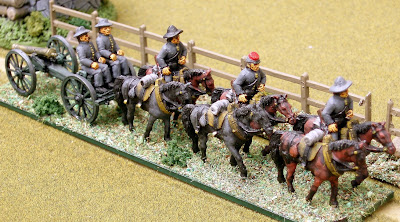 Time for some of the heavy boys in the ACW - and this one really is very heavy...!
Time for some of the heavy boys in the ACW - and this one really is very heavy...! As per the unit histories of the other two regiments I've painted so far for the Confederacy, this unit also started off as a volunteer/militia unit.
The "Alleghany Roughs" was an infantry unit from Covington in Alleghany County, Virginia. They came into being on the 20th April, 1861. A few weeks later the unit was mustered into service at Harpers Ferry, Virginia and officially became company A of the 27th Virginia Regiment of the 1st Virginia Brigade of Infantry.
As infantry the unit fought with distinction at Manassas junction, where along with their fellow brigade companions they became known for the first time as the Stonewall Brigade.
The "Alleghany Roughs", or Company A's, first commander was Captain Thomas McAllister but due to illness, he was forced to relinquish command after Manassas to his 1st Lieutenant, Joseph Hanna Carpenter.
When reviewing this change of command, Stonewall Jackson recognised Carpenter's name as one of his former artillery students at the Virginia Military Institute (VMI), and on orders from Jackson, the unit was converted from infantry to artillery.
The new unit was called the "Alleghany Artillery" but was known thereafter as "Carpenter's Battery."
 The unit numbered approximately 80 men at the time of conversion to an artillery battery, fielding four iron 6-pounder guns from the foundry at Tredegar works in Richmond, Virginia.
The unit numbered approximately 80 men at the time of conversion to an artillery battery, fielding four iron 6-pounder guns from the foundry at Tredegar works in Richmond, Virginia. By the time they'd got to Gettysburg the unit had acquired two 12-pounder Napoleons and two 3-inch Ordnance Rifles (which were probably captured). The battery remained at fighting strength through most of the war by the addition of new recruits and by gaining the remnants of disbanded artillery units.
 Over the course of the war the battery lost 46 men killed and 124 badly wounded. At the formal surrender on the ninth day of April, 1865, the battery had only two men in attendance.
Over the course of the war the battery lost 46 men killed and 124 badly wounded. At the formal surrender on the ninth day of April, 1865, the battery had only two men in attendance.
Figures are 20mm, and as per the other units so far by Newline Designs. The limber base is very heavy and I have it mounted on 2mm plastic card - for the next battery (which will be Union) I think I'm going to try and alternative basing method and mount the front pairs of horses separately to cut down on weight - in fact that may still be the plan for these guys! Let's see...
I've painted these to represent a battery of 12lb'er brass Napoleons, not strictly realistic according to some histories I've seen (including the above), but it does match the OOB I have, and these guns were the main stays of both sides artillery..
 Next on the painting table are the dismounted crews and the bases to take the actual guns... I'm planning to adopt the same idea I had for the Sudan project, with the crews based on stands but the guns free standing so that I can use them to attach to the back of the limber, or swap for other types of gun once I get some, or even to allow them to be abandoned should the need arise..
Next on the painting table are the dismounted crews and the bases to take the actual guns... I'm planning to adopt the same idea I had for the Sudan project, with the crews based on stands but the guns free standing so that I can use them to attach to the back of the limber, or swap for other types of gun once I get some, or even to allow them to be abandoned should the need arise..
These are VERY impressive figures Sir! I know that their wargames role may be limited-but limbers and crew do look very cool and this is a first rate treatment (much doffing of the e-hat here!).
ReplyDeleteNice history too.
Matt
Gamers who say that limbers are unnecessary have no soul. I've outfitted my Napoleonic forces with limbers and caissons. There's something heartwarming about a well stocked artillery park. I must say Steve that the Newline figures are lovely little casting. I have a few myself and I've always found satisfactory.
ReplyDeleteAbandon the guns?!! Perish the thought suh! A fine looking battery so far. I ahve a fondness for limbers and associated paraphanelia. Sometimes takes me forever to get them added but they are always on the books to be done. An idea I am toying with going forwards, taken from a Peter Guilder article, is to represent a limbered battery with 1 limbered gun while doing the unlimbered battery as 2 guns. Has to do with fitting the limbered battery oin table (in my case in 40mm)
ReplyDeleteI like the way your 20mm acw is coming together.
-Ross
I agree with oters that limbers give a look and a feel to the tabletop that goes beyond their mere presence.
ReplyDeleteI always liked gilders basing of limbers - two parts with a semi-circular end to each where the two meet to allow the limber to go round bends in roads. Aesthetically very pleasing. I'm sure he also added a base of infantry marching behind to represent the crew. Very early article in Wargames Illustrated I think.
A really nice piece!
ReplyDeleteIan
Thanks guys - appreciated... I know what some of you are saying; if you don't have limbers represented on the table top how do you move the guns?! :o))
ReplyDeleteGreat stuff, Steve. Lovely photo of the real life gun too.
ReplyDeleteBest wishes
Giles